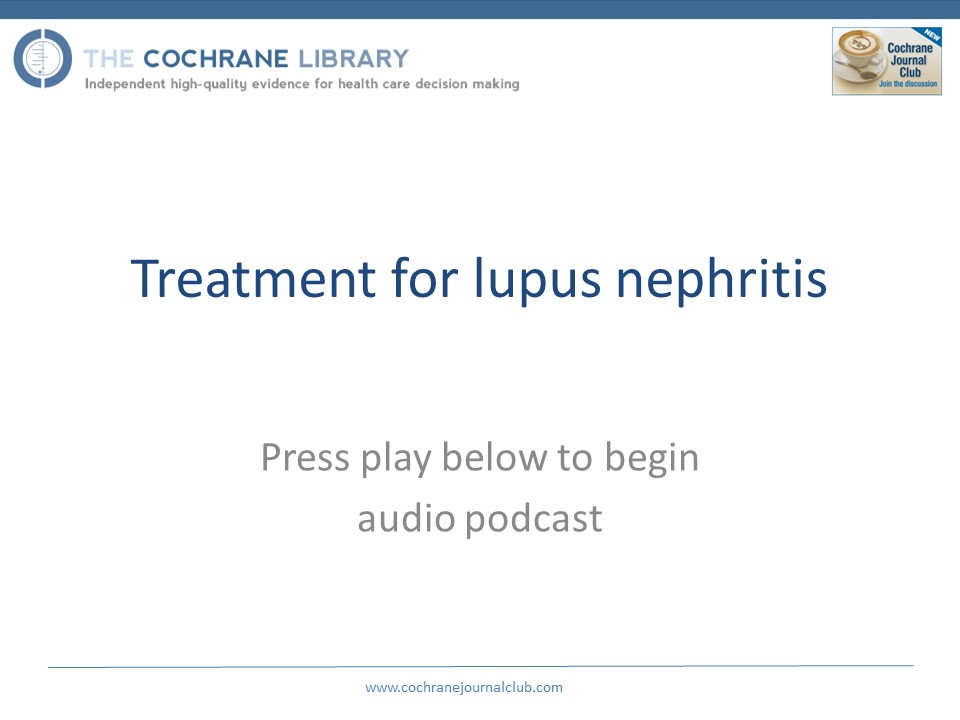Cochrane Library: Treatment for Lupus Nephritis
Introduction
Introduction
Lupus nephritis is an inflammatory condition affecting the kidneys which is caused by systemic lupus erythematosus (SLE), an autoimmune disease that is more common among women. About half of all people with SLE develop lupus nephritis, and of these about 1/10 experience chronic kidney disease or kidney failure. Treatment aims to delay disease progression and achieve remission by stabilising and improving kidney function and minimising side effects. For about the past 30 years, standard treatment for lupus nephritis has focused on a combination of cyclophosphamide (an alkylating agent) and corticosteroids. This Cochrane review assesses the benefits and harms of different immunosuppressive treatments in biopsy-proven proliferative lupus nephritis.
Authors
 |
Lorna Henderson is a Nephrologist based in Edinburgh, and who trained in Scotland and Australia. During a fellowship year at Westmead Hospital in New South Wales, Lorna spent some time training with the Cochrane Renal Group, and working on the review update of treatment for Lupus Nephritis. She has an interest in transplantation and evidence based practice. |
 |
Angela is a Nephrologist and Transplant Physician, having trained in England, Scotland and Australia. She also works at the University of Sydney as a Clinical Epidemiologist and is the Deputy Coordinating Editor of the Cochrane Renal Group |
Copyright© 2014 The Cochrane Collaboration. Published by John Wiley & Sons, Ltd.
Summary
Summary
Lupus nephritis occurs in about half of all people with systemic lupus erythematosus (SLE), leading to end-stage kidney disease (ESKD) in 5% to 10% of patients at 10 years. Studies in the 1970s and 1980s led to the establishment of cyclophosphamide-containing regimens as first line therapy for inducing remission, and survival is now greater than 90%. However, Cyclophosphamide is toxic and associated with high incidence of adverse events. Furthermore, response to treatment is often slow, and although remission is induced in a significant proportion of patients, the risk or relapse or flare remains considerable.
In the past ten years, numerous trials evaluating newer agents (mycophenolate mofetil (MMF), tacrolimus and rituximab) have been published. These have all been proposed as alternative, potentially less toxic, and more effective therapies than cyclophosphamide. This December 2012 update to a Cochrane Review that was last revised in 2004 seeks to evaluate the relative effects of all available immunosuppressive therapies for the induction or maintenance treatment of lupus nephritis.
The principal sources of trials for the review was the Cochrane Renal Groups Specialized Register, which includes more than 18,000 reports. It is the best single source of published trials for inclusion in systematic reviews in kidney disease, and draws on searches of the Cochrane Central Register of Controlled trials, general bibliographic databases of health research such as MEDLINE and EMBASE, and the checking of specialised databases, journals and conference proceedings.
Two authors independently screened all titles and abstracts to determine which studies to include. Data were extracted and quality assessed independently by two authors, with differences resolved by discussion.
A total of 50 trials involving 2846 randomized participants were included in the review. Most of these were of induction therapy, with six studies (514 participants) comparing different forms of maintenance therapy. Many different comparisons had been investigated in the trials, making it difficult to use this large amount of data to answer specific questions; but two comparisons stood out.
Seven trials, including a total of 710 patients, compared MMF against conventional therapy with intravenous cyclophosphamide for induction treatment. In the short term (up to six months), treatment with MMF conferred similar risk of death and progression to end-stage kidney disease as intravenous cyclophosphamide. Renal remission and renal relapse were equally likely with each agent; but MMF was associated with less ovarian failure, leucopenia and alopecia. However, it seemed to increase the risk of diarrhoea.
Three trials (including a total of 371 patients) compared MMF with azathioprine for maintenance therapy. MMF was associated with a significantly lower risk of renal relapse.
Across the review, there is considerable clinical heterogeneity in interventions, definitions of remission, and outcome reporting. These hampered interpretation and presentation of important outcomes in this review. For example, even in the comparison of MMF versus cyclophosphamide, there was variability among studies in therapeutic dosing, route of administration and co-interventions.
There is also a problem with the duration of follow-up in the trials. Although some studies followed patients for one to two years, others were much shorter and inadequately powered to detect events in the clinically important outcomes. For example, the average time to remission with cyclophosphamide is about 10 months, but 10 of the induction therapy studies did not follow their participants beyond six months. Furthermore, the risk of adverse events such as ovarian failure increases after six months, so the power of existing studies, even when combined, to detect significant differences among interventions is limited. The lack of long-term follow-up is particularly relevant to the outcome of ESKD, where a difference between treatments may not become apparent for several years.
In their conclusions, the authors of this updated review draw attention to the similar effects for induction of remission of proliferative lupus nephritis with MMF compared to cyclophosphamide. They draw attention to the significant reduction in toxic effects (ovarian failure, alopecia and leucopenia) with MMF, but note that the significant increase in diarrhea may limit its widespread tolerability. However, particularly for women of child-bearing age, they suggest that the equivalent remission rates combined with a more favourable side-effect profile would support MMF as being superior to cyclophosphamide as induction therapy for lupus nephritis.
In considering the questions that need to be addressed in future studies, the authors reflect on the fact that many of the treatments that are used for lupus nephritis, including rituximab, tacrolimus and cyclosporin, have only been assesses in small randomized trials, with inconsistent outcome reporting. They highlight two main implications for research: firstly, to make better use of existing data, and secondly to strategically plan any new studies. This recognizes that lupus nephritis is uncommon, and requires multicentre collaboration for any study to have an adequate sample size and prolonged follow-up beyond six months to clarify the harms of specific treatment regimens.
Copyright© 2014 The Cochrane Collaboration. Published by John Wiley & Sons, Ltd.
Audio Podcast
Audio Podcast

Presentation
Presentation
Note: Audio not available
Copyright© 2014 The Cochrane Collaboration. Published by John Wiley & Sons, Ltd.
Questions
Questions
1. What do you think of the findings of this Cochrane Review?
- This review brings together studies testing a variety of induction and maintenance therapies for people with lupus nephritis. Do you prefer this wide-ranging approach or the more focused questions in some Cochrane Reviews which look at a single comparison only?
- The authors relied mainly on a search of the specialized register of the Cochrane Renal Group to look for studies for their review, rather than doing their own searches of databases such as MEDLINE and EMBASE. What are the advantages and disadvantages of this approach?
2. How should this review influence decisions about treatments for lupus nephritis?
- Few of the intervention comparisons could be brought together in meta-analyses in this review, because of the lack of similar comparisons and the large amount of heterogeneity in the ways that outcomes were measured or reported. If you already knew the results of individual studies that are included in the review, would the review change your confidence about using the results of those studies when making a decision?
- If you were responsible for designing a new randomised trial of induction therapy for people with lupus nephritis, how many, and which, drugs would you compare?
3. Would other information help in making a decision about treatments for people with lupus nephritis?
- Most of the trials in this review did not follow patients for more than one year, which is too short to detect the effects on some important outcomes. How would you decide on the optimum length of follow-up and, if this proved to be difficult in randomised trials, what other study designs might be used?
- If you were a research funder, what things would you consider if you were asked to fund 10 years of follow-up for trials that have already been done or a new trial with 1 year of follow-up?
- What evidence would you look for to decide if the results from the trials of induction therapy might help when making decisions about maintenance therapy?
Copyright© 2014 The Cochrane Collaboration. Published by John Wiley & Sons, Ltd.
Resources
Resources
Access the Cochrane Review
Access other resources
1. Dehydroepiandrosterone for systemic lupus erythematosus
Assessing the effectiveness and safety of dehydroepiandrosterone compared to placebo in the treatment of people with systemic lupus erythematosus.
2. Cyclophosphamide versus methylprednisolone for treating neuropsychiatric involvement in systemic lupus erythematosus
Assessing the benefits and harms of cyclophosphamide and methylprednisolone in the treatment of neuropsychiatric manifestations of SLE.
3. Access other reviews from the Cochrane Renal Group
4. Search for reviews from the Renal Group using The Cochrane Library
Copyright© 2014 The Cochrane Collaboration. Published by John Wiley & Sons, Ltd.
